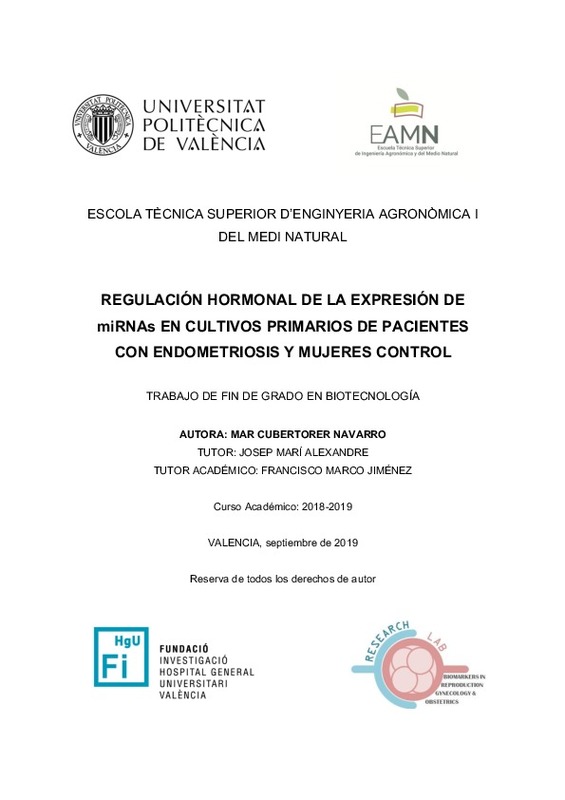|
Resumen:
|
[ES] La endometriosis es una enfermedad ginecológica benigna, inflamatoria y dependiente de estrógenos que afecta al 6-10% de mujeres en edad reproductiva. Se trata de una enfermedad altamente invalidante caracterizada por ...[+]
[ES] La endometriosis es una enfermedad ginecológica benigna, inflamatoria y dependiente de estrógenos que afecta al 6-10% de mujeres en edad reproductiva. Se trata de una enfermedad altamente invalidante caracterizada por la presencia de dolor en distintas circunstancias e infertilidad, afectando notablemente a la calidad de vida de las pacientes. Los estrógenos juegan un papel fundamental en su fisiopatología ya que promueven el crecimiento y la invasión de la lesión endometrial. Los microRNAs (pequeñas moléculas de RNA no codificantes) regulan la expresión génica a nivel post- transcripcional. Hay evidencia de que la desregulación en la expresión de ciertos miRNAs está involucrada en la fisiopatología la endometriosis. No obstante, existen pocos trabajos acerca de la influencia de los estrógenos en la regulación de los miRNAs en esta patología, por lo que el objetivo principal del presente trabajo ha sido estudiar dicha influencia. Para ello, se han empleado cinco cultivos primarios de células estromales de endometrio de mujeres con y sin endometriosis y de lesiones endometriósicas, y una línea celular epitelial ya establecida. Tras la caracterización morfológica de las células de estudio, se ha determinado la presencia de ESR1 en todos los cultivos celulares, así como la viabilidad de la técnica de TRIzol para el aislamiento del RNA total sin sesgar la extracción de los miRNAs de interés (miR-99a-5p, let-7c-5p, miR-143-3p, miR-424-5p y miR-29c-3p). Además, mediante análisis bioestadísticos se ha establecido let-7c como normalizador frente a U6 snRNA. Finalmente, se ha observado que, tras el tratamiento con estradiol a dosis 10-9 M, los miR-424-5p y miR- 29c-3p aumentan en la línea celular epitelial Ishikawa y el miR-143-3p aumenta en los cultivos de células estromales procedentes de endometrio control y eutópico.
[-]
[EN] Endometriosis is a benign, inflammatory and estrogen-dependent gynecological disease that affects 6-10% of reproductive-age woman. It is a highly disabling disease characterized by the presence of pain in different ...[+]
[EN] Endometriosis is a benign, inflammatory and estrogen-dependent gynecological disease that affects 6-10% of reproductive-age woman. It is a highly disabling disease characterized by the presence of pain in different circumstances and infertility, so it significantly affects the quality of life of the patients. Estrogens play a fundamental role in its pathophysiology as they promote the growth and invasion of the endometrial lesion, and microRNAs (small non-coding RNA molecules) regulate gene expression at the post-transcriptional level. There is evidence that deregulation in the expression of certain miRNAs is involved in endometriosis pathophysiology. However, there are few studies focused on the influence of estrogen in the regulation of miRNAs in this pathology, so the main objective of the present work has been to study this influence. For this purpose, five primary cell cultures of stromal endometrial cells from women with and without endometriosis and from endometriotic lesions have been used, as well as an established epithelial cell line. After the morphological characterization of the study cells, the presence of ESR1 in all cell cultures has been determined, as well as the feasibility of the TRIzol technique for the isolation of total RNA without biasing the extraction of the miRNAs of interest (miR- 99a-5p, let-7c-5p, miR-143-3p, miR-424-5p and miR-29c-3p). In addition, let-7c has been established as a normalizer by means of biostatistical analysis, instead of U6 snRNA. Finally, it has been observed that after the treatment with estradiol at a dose of 10-9 M, miR-424-5p and miR-29c-3p expression has been increased in the Ishikawa epithelial cell line, and miR-143-3p in stromal cell culture coming from control and eutopic endometrium.
[-]
|




![PDF file [Pdf]](/themes/UPV/images/pdf.png)



